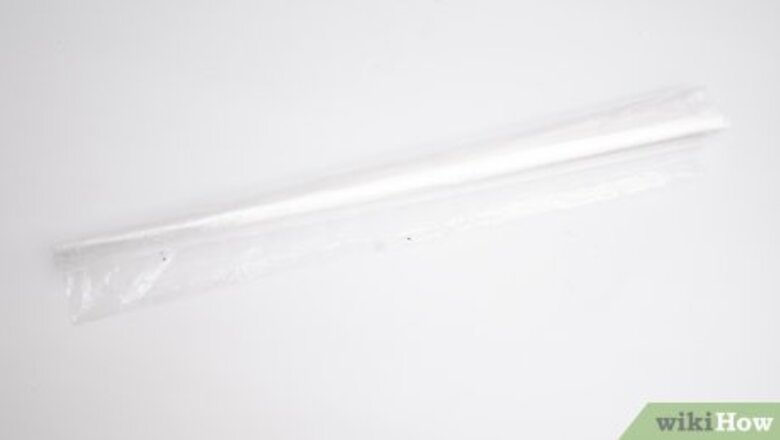
views
Using Clear Plastic
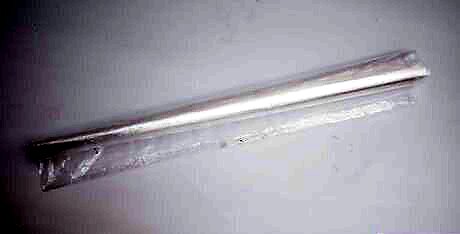
Purchase a roll of clear plastic that is 1-4 mils thick. The thickness of plastic film is measured in mils. The majority of plastic book covers range from 1-2 mils in thickness, although you can purchase sheets of thicker plastic if you’re expecting extreme wear and tear on your book. The thicker the plastic, the more expensive it will be. Rolls of plastic typically come in heights ranging from 9 inches (23 cm) to 16 inches (41 cm). Select a height that will fit the book you plan to cover. A standard textbook is generally 8.5 inches (22 cm) by 11 inches (28 cm), meaning you should cut your plastic to be 14.5 inches (37 cm) by 17 inches (43 cm).
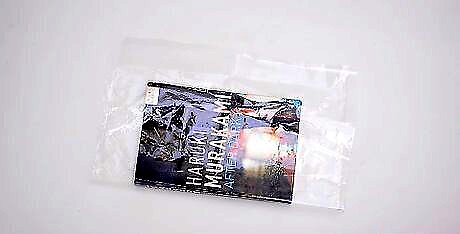
Measure and cut the plastic 3 inches (7.6 cm) above and below the book. Lay out a piece of plastic on a hard flat surface and place the book in the center. Using a ruler, measure 3 inches (7.6 cm) above the top and trim horizontally along that line. Repeat with the bottom edge of the book, measuring 3 inches (7.6 cm) and then cutting off the excess plastic.
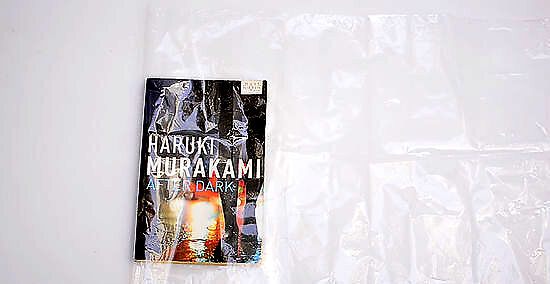
Mark and cut 3 inches (7.6 cm) of additional plastic on either side of the book. Measure the width of the book by laying it rightside up, marking the right edge with a washable marker, then flipping it onto its spine and over to its back and marking the left edge. Make straight, vertical cuts 3 inches (7.6 cm) out from these markings. You should end up with a 3 inches (7.6 cm) border of extra plastic.
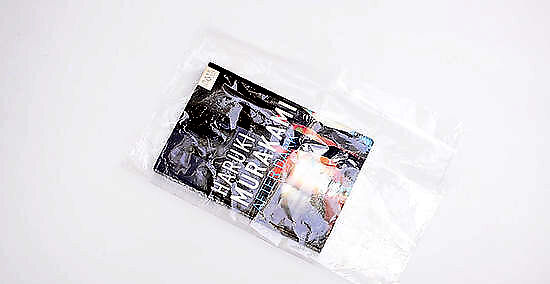
Fold the plastic around your book, then tuck in the front flap. Fold the plastic around your book so 2 equally-sized flaps are hanging off the top, bottom, and right side. Fold the front plastic flap under the front cover, pull tight, and tape it in place with a piece of Scotch tape. This will keep the plastic from shifting around as you complete the rest of the steps.
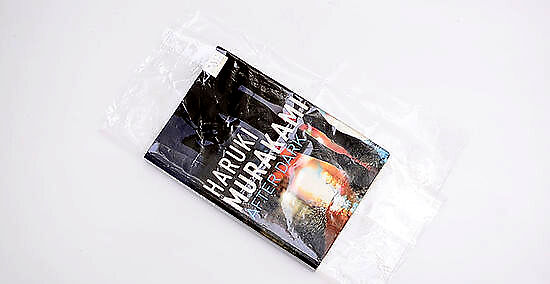
Tuck the bottom flap under the back cover but do not tape. Flip the book over and fold in the back flap of plastic around the back cover. Do not tape this flap like you taped the front flap. Press down firmly across the crease in the plastic to create a more defined fold.
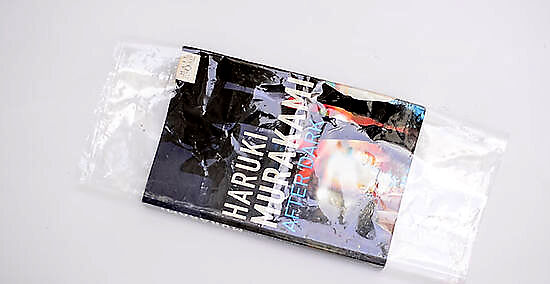
Cut 2 spinal tabs into your plastic cover. Make a vertical cut in the plastic about 1 inch (2.5 cm) in from where the plastic folds around the spine. Do this 4 times—twice on the top flap and twice on the bottom flap. You will end up with 2 tabs that are slightly wider than the spine of your book. Cut right up to the edge of the book, but don’t go so far that you accidentally cut the cover. Long sharp scissors will make this job easier.
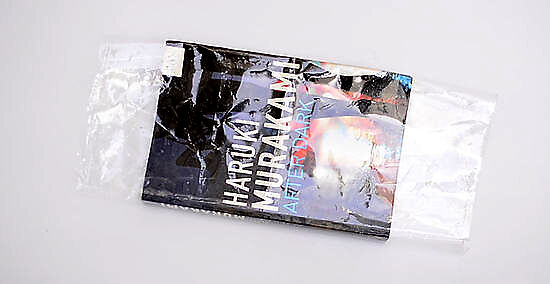
Snip off each corner of the plastic cover at an angle. Bring your scissors right up to the corner of the book cover and cut upwards and inwards at an angle to snip off a triangle of plastic. You’ll be cutting through 2 layers of plastic. Do this to the 2 front corners, then flip the book over and repeat with the 2 back corners. Discard the excess plastic triangles that you’ve cut off.

Open the book to the back cover and cut off the inner plastic flaps. Once you’ve snipped off the corners, you will be left with 2 separate flaps at the top and at the bottom of the back cover. Starting at the top corner of the book cover, cut at a slight downwards angle to slice off the inner flap of plastic. Repeat with the bottom corner, cutting at a slight upwards angle instead. Do the same for the front cover.
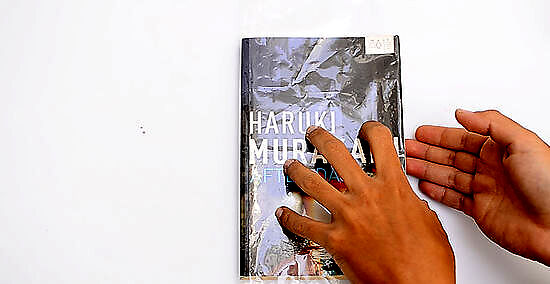
Slide off the back cover and fold in the spinal tabs. Slide the plastic fold off the back cover. Lay the plastic cover flat on your work surface and lift the book up slightly so the spinal tabs are visible. Fold them in and press down firmly on the crease with your fingers.
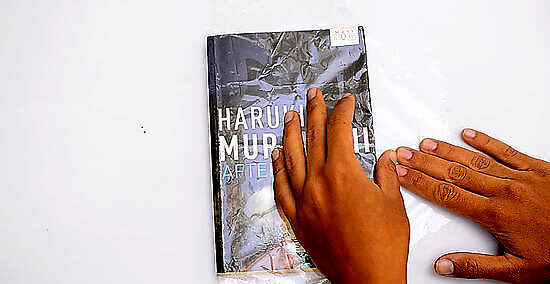
Put the cover back on, tuck in the remaining flaps, and tape them. Fold the plastic back over the back cover of your book. Then, fold in the top and bottom plastic flaps hanging off the back cover and secure them with tape. Repeat for the front cover. When you are taping down the flaps, try taping from plastic to plastic to avoid applying the adhesive to the book itself, which could rip the paper when you remove the tape. Make sure the plastic is pulled as flat and tight as possible around the book when you tape it. This method is less likely to damage your book when you remove the cover, compared to covering it in contact paper, since there’s less adhesive involved.
Wrapping in Contact Paper

Measure and cut the contact paper to the appropriate height. Lay out a piece of transparent contact paper on a hard flat surface, then put the book in the center. Using a ruler, measure 2 inches (5.1 cm) above the top and bottom and trim horizontally along both lines. Most contact paper comes with pre-printed grids, in which case you may not need a ruler to measure.
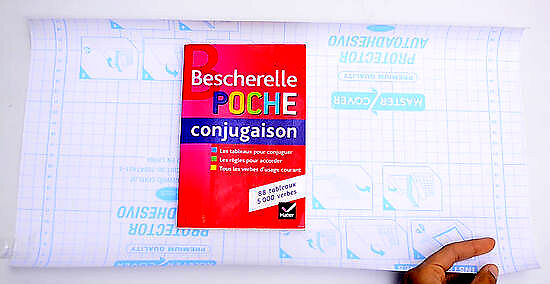
Cut the contact paper so it's three times the width of your book. Measure the width of your book from the right edge to the left edge. Cut your contact paper so that its width is triple that of the book you’re planning to cover. Use a pair of long sharp scissors, which will allow you to make long gliding cuts through the contact paper. Follow one of the printed grid-lines for a straighter cut.
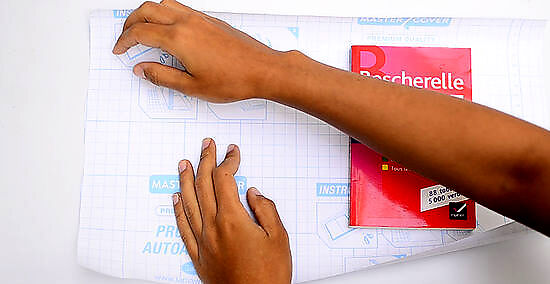
Begin peeling the contact paper along the left edge and fold it down. Starting at the corner, peel the sticky contact paper away from its backing paper. Expose about 2 inches (5.1 cm) of the sticky contact paper, which should be facing up. Fold the backing paper over to the left. Side your finger along the crease while pressing down to secure the fold.

Place the book cover side down on the sticky contact paper. Just the edge of the front cover should be touching the contact paper. Once you’ve correctly positioned your book, press down on the book to secure the adhesive of the contact paper. The edge of the books should be parallel to the edges of your contact paper. There should be about 2 inches (5.1 cm) of excess contact paper sticking out from the cover at this point. You will fold this over later.
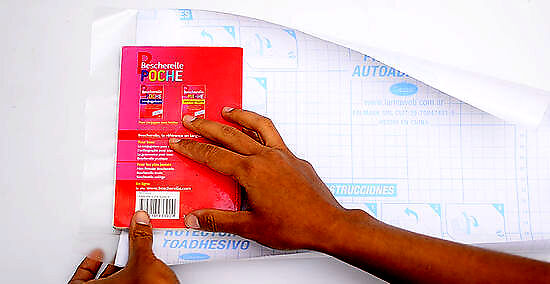
Flip the book cover side up and press out the bubbles. Using your fingers, press out any air bubbles that may have been trapped between the contact paper and the book cover. Keep the extra piece of sticky contact paper from touching the table and getting stuck. You can also use a plastic card or a ruler to press out air bubbles.
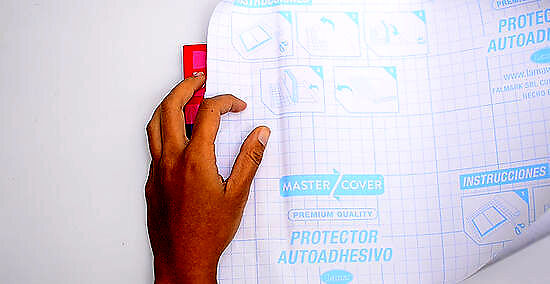
Pull away the contact paper backing while pressing down with a ruler. Lift up the contact paper and you will see the folded piece of paper backing. Grab this and pull towards the spine of the book, firmly but slowly. This will reveal more sticky contact paper, which you should press into the cover of the book with a plastic ruler. The ruler also works to press out air bubbles, giving your cover a neater look. Stop when you get to the end of the front cover.
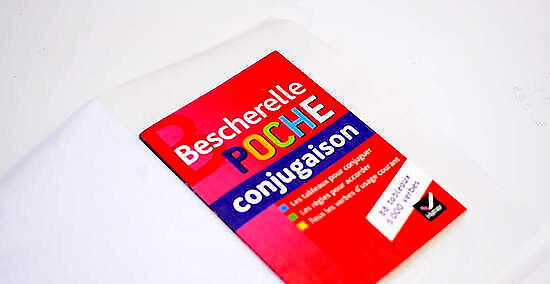
Cut off the 2 corners of the contact paper at an angle. The line you cut along should intersect with the actual corner of the book cover, resulting in a triangle-shaped piece of contact paper. Save these triangle pieces of contact paper by sticking them to the edge of a table or counter. Be careful not to actually snip off the corner of the book cover, however.
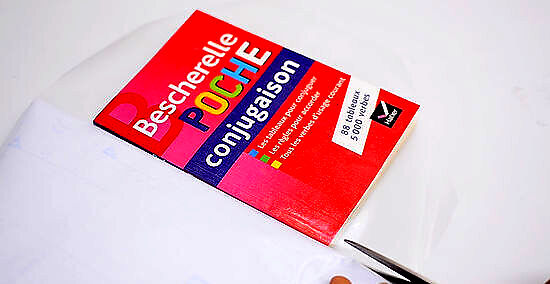
Cut another triangle near the spine from the top and bottom flaps. Cut vertically about 1 inch (2.5 cm) in from the spine, then make another angled cut along the bottom edge so you remove a triangle-shaped piece of contact paper. Save these pieces of contact paper, as well. Repeat with the top flap of contact paper.
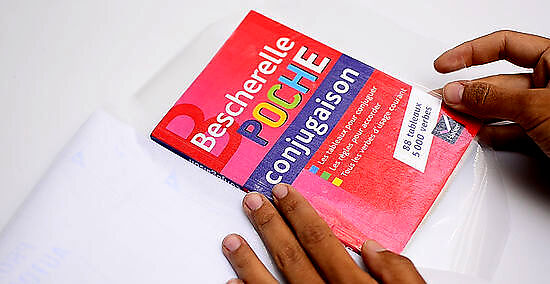
Fold in the 3 flaps of contact paper and press down to secure them. At this point, you will have 3 flaps of contact paper around the top, bottom, and right edge of the front cover. Fold them in, one at a time, and press gently with your hand to adhere the flaps to the inside of the front cover. Press the triangles of contact paper you saved into each corner of the inside cover to provide extra security and keep the contact paper in place over time.
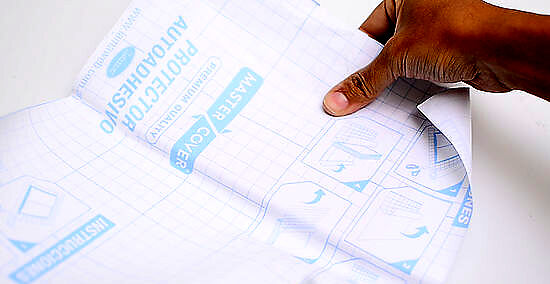
Continue pulling away the paper backing. Gently and slowly pull the paper backing away while sliding the ruler over the contact paper to press it down and remove any air bubbles. First, cover the spine, then keep pulling until you’ve reached the edge of the back cover. Cut off any extra contact paper, if needed. You want about 3 inches (7.6 cm) left sticking out.
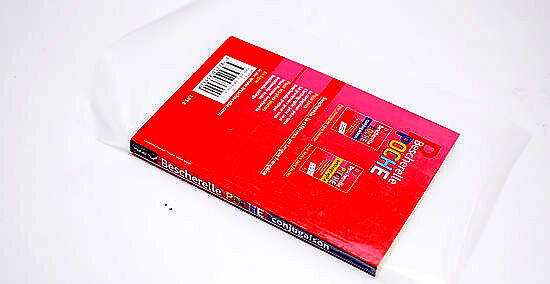
Snip off the corners of the contact paper into 2 triangle shapes. Once you’ve applied the contact paper to the entire back cover, you will cut the contact paper in the same way as you did for the front cover. Use scissors to cut a line that intersects with the actual corner of the book cover. Save these 2 triangle pieces of contact paper. Be careful not to accidentally cut off the corner of the book cover.
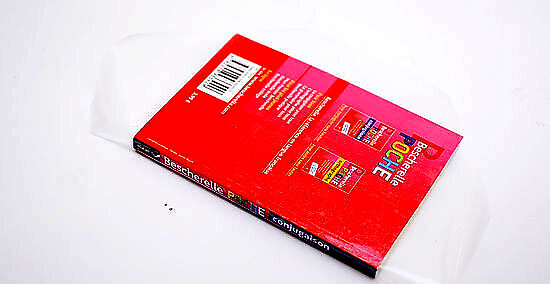
Cut another triangle of contact paper from the top and bottom flaps. In the same way as you did for the front cover, cut vertically 1 inch (2.5 cm) from the spine, then make another angled cut along the bottom edge that results in a triangle-shaped piece of contact paper. Remove this piece and set it aside for later. Repeat this set of cuts with the top flap of contact paper.
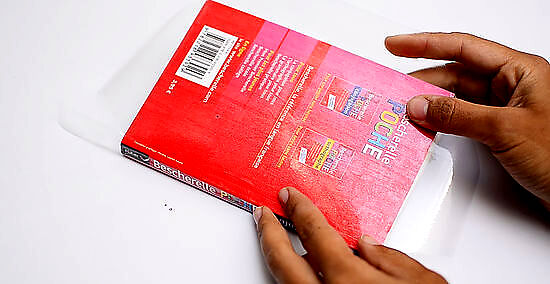
Fold in each flaps of contact paper and press to secure them. At this point, you will have 3 flaps of contact paper around the top, bottom, and right edges of the front cover. Fold them in one at a time and press gently with your fingers to adhere the flaps to the inside of the front cover. Press the triangles of contact paper you saved into each corner of the inside cover to provide extra security and keep the contact paper in place over time. Pull tight on the flaps as you press them down to avoid trapping air bubbles underneath.
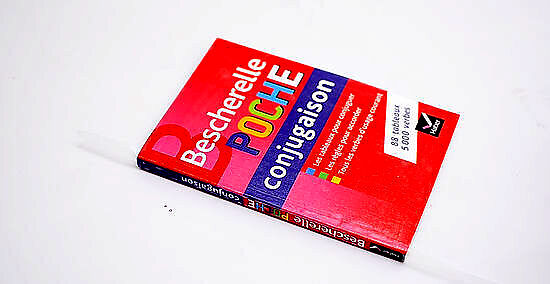
Cut off the spinal tabs to complete the cover. There will be 2 remaining flaps of contact paper sticking out from either end of the spine. Cut carefully along the edge of the book to remove the flaps. Be careful when cutting this close to the book, and make sure not to cut the book itself. Throw away these pieces of contact paper.




















Comments
0 comment